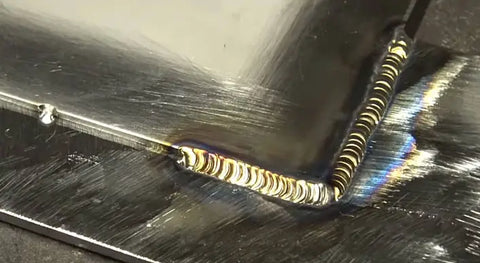Can You MIG Weld Stainless Steel?
Mar 31, 2024
For aspiring and experienced welders alike, the world of stainless steel holds a unique allure. This versatile material, prized for its strength, corrosion resistance, and aesthetics, finds applications across countless industries. But what about joining these gleaming pieces of metal? Can MIG welding, a popular and widely used technique, be used to create robust stainless steel welds? The answer, with a few considerations, is a resounding yes! But, let's not miss a chance to discover more about the world of MIG welding and its compatibility with stainless steel.

What is MIG Welding
MIG welding, also known as Gas Metal Arc Welding (GMAW), is a versatile arc welding process that utilizes a continuously fed consumable electrode wire. As the current flows through the wire, it heats it intensely, causing it to melt and transfer in droplets across the arc to the weld pool. A shielding gas continuously envelopes the arc and molten metal, protecting them from contamination by the surrounding atmosphere. This shielding gas plays a crucial role in achieving clean and strong welds.
The MIG process offers several advantages, making it a popular choice for various welding projects. Here are some key features:
- Versatility: MIG welding can be used to join a wide range of metals, including mild steel, stainless steel, aluminum, and even certain types of nickel alloys.
- Ease of Use: Compared to other arc welding techniques, MIG welding is generally considered easier to learn and control. The continuous wire feed and readily available shielding gas simplify the process.
- Clean and Spatter-Free Welds: The shielding gas effectively protects the weld pool from contamination, leading to clean and spatter-free welds with a smooth appearance.
- Good Weld Penetration: MIG welding can achieve good penetration into the base metal, creating strong and reliable joints.
MIG Welding and Stainless Steel
So, can MIG welding be used to join the ranks of stainless steel? Absolutely! While MIG welding stainless steel presents some unique challenges compared to mild steel, it's a highly effective method for creating strong and aesthetically pleasing welds when the proper techniques and considerations are applied.
For the welding of stainless steel, it is necessary to understand our MIG-250. It uses MIG welding machines with advanced IGBT inverter technology to ensure high performance and reliability for all types of welding tasks.
Here's what makes MIG welding suitable for stainless steel:
Controllable Heat Input:
The ability to precisely control the heat input through adjustments to voltage, wire feed speed, and travel speed is crucial for stainless steel welding. Excessive heat can damage the chromium layer responsible for corrosion resistance, leading to a phenomenon called "weld decay." MIG welding allows for fine-tuning of heat input to achieve optimal results.
Shielding Gas Selection:
Utilizing the appropriate shielding gas is vital for protecting the weld pool from contamination and preserving the corrosion resistance of the stainless steel. Tri-mix gas blends containing argon, helium, and carbon dioxide are often preferred for MIG welding stainless steel.
Advantages and Limitations of MIG Welding Stainless Steel
While MIG welding offers a viable solution for joining stainless steel, it's essential to understand the advantages and limitations of this technique:
Advantages:
Faster Welding Speeds:
Compared to other techniques like TIG welding, MIG welding generally allows for faster welding speeds due to the continuous wire feed and ease of control. This can be beneficial for applications demanding high productivity.
Cost-Effectiveness:
MIG welding equipment is often more affordable compared to some other arc welding processes. Additionally, the use of a consumable electrode wire eliminates the need for separate tungsten electrodes used in TIG welding, further reducing consumable costs.
Out-of-Position Welding:
MIG welding can be effectively used for out-of-position welding, such as vertical or overhead welds, making it suitable for various applications where access might be limited.
Limitations:
Susceptibility to Weld Decay:
As mentioned earlier, excessive heat input during MIG welding can damage the chromium layer in stainless steel, leading to a loss of corrosion resistance in the heat-affected zone (HAZ) around the weld. This necessitates careful control of heat input and selection of appropriate welding parameters.
Wind Sensitivity:
The shielding gas used in MIG welding can be susceptible to wind disturbances, making it less ideal for outdoor applications with strong winds. TIG welding, with its more focused arc and concentrated gas coverage, might be better suited for windy conditions.
Lower Weld Quality Compared to TIG:
While MIG welding can produce strong and functional joints, experienced welders might achieve a slightly higher quality and more aesthetically pleasing weld with TIG welding due to its more precise arc control and minimal spatter.
Stainless Steel Thicknesses and Specifications
The successful MIG welding of stainless steel hinges on selecting the appropriate settings and materials based on the specific thickness and grade of the stainless steel you're working with. Here's a breakdown to guide you:
Stainless Steel Thickness:
Thin Sheet Metal (Below 1/8 inch):
For thin stainless steel sheets, a lower heat input is critical to prevent burn-through and minimize warping. Utilize a small diameter solid wire (around 0.023 - 0.030 inches) and a low voltage and wire feed speed setting. Shielding gas blends high in argon (often 90% or more) are recommended for optimal protection.
Medium Thickness (1/8 inch to 3/16 inch):
As the thickness increases, slightly higher heat input can be tolerated. Solid wires with a diameter of 0.030 - 0.035 inches can be used with adjustments to voltage and wire feed speed to achieve proper penetration without excessive heat. Tri-mix gas blends containing argon, helium, and a small amount of carbon dioxide (around 1-2%) offer a good balance between arc stability and penetration.
Thicker Materials (Above 3/16 inch):
For thicker sections, even higher heat input might be necessary to achieve full penetration. Larger diameter solid wires (0.045 inches or even thicker) can be employed along with higher voltage and wire feed speed settings. However, exercising caution to prevent excessive heat and weld decay remains crucial. In some cases, multi-pass welding techniques might be necessary to achieve complete penetration in thicker sections.
Stainless Steel Specifications:
The specific grade or type of stainless steel also plays a role in selecting the optimal welding parameters. Here are some general considerations:
Austenitic Stainless Steels (304, 316):
These common grades are generally considered good candidates for MIG welding due to their relatively good weldability. Standard tri-mix gas blends work well for these types.
Ferritic Stainless Steels (409):
These grades might require slightly different welding parameters due to their lower nickel content, which can affect weldability. Consulting welding procedure specifications (WPS) or experienced welders is recommended for these types.
Duplex Stainless Steels:
These grades require specific attention due to their unique microstructure. Preheating the base metal, utilizing specific filler metals and shielding gases might be necessary. Consulting a welding professional is highly recommended for welding duplex stainless steels with MIG.
Frequently Asked Questions (FAQs)
What type of wire should I use for MIG welding stainless steel?
Solid wires specifically designed for stainless steel welding are recommended. The diameter and type of wire will depend on the thickness and grade of the stainless steel you're working with.
Can I use regular MIG settings for stainless steel?
No, using regular MIG settings for mild steel might not be suitable for stainless steel. Stainless steel requires a more controlled heat input to prevent weld decay. Adjusting voltage, wire feed speed, and selecting the appropriate shielding gas are crucial for successful stainless steel MIG welding.
What safety precautions should I take when MIG welding stainless steel?
Always wear appropriate personal protective equipment (PPE) including a welding helmet with the correct shade lens, welding gloves, flame-retardant clothing, and respiratory protection to protect yourself from fumes generated during the welding process.
Conclusion:
MIG welding offers a powerful and versatile tool for joining stainless steel. By understanding the principles of MIG welding, the specific considerations for stainless steel, and selecting the appropriate techniques and materials, you can achieve strong, functional, and even aesthetically pleasing welds.
So, the next time you have a stainless steel project on your hands, don't shy away from MIG welding. With the right knowledge and practice, you can create beautiful and lasting metal bonds.




